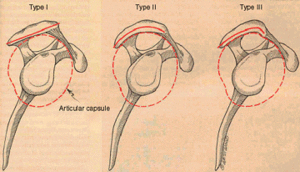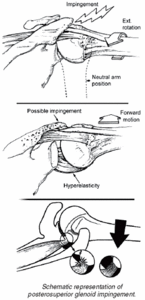New York's highest court of appeals has held that no-fault insurers cannot deny no-fault benefits where they unilaterally determine that a provider has committed misconduct based upon alleged fraudulent conduct. The Court held that this authority belongs solely to state regulators, specifically New York's Board of Regents, which oversees professional licensing and discipline. This follows a similar recent ruling in Florida reported in this publication.
Shoulder Impingement Syndromes
Charles Neer first established the concept of impingement in 1972. He described this condition as subacromial outlet obstruction resulting in irritation of the supraspinatus tendon.1
Shoulder Impingement Syndromes
- primary impingement
- secondary impingement
- subcoracoid impingement
- posterior-superior glenoid impingement
a. "internal glenoid impingement"
Primary Impingement
Etiologies of primary impingement:
- subacromial spurring
- subacromial fibrosis
- acromioclavicular (AC) joint spurring
- type II or III acromion
- os acromiale
Type I: < 25 years of age, reversible, swelling, tendonitis, no tears, conservative treatment.
Type II: 25-40 years of age, permanent scarring, tendonitis, no tears, subacromial decompression (SAD).
Type III: > 40 years of age, small RTC tear, SAD with debridement/repair.
Type IV: > 40 years of age, large RTC tear, SAD with repair.
Acromial Morphology
Type I Acromion: flat, minimal impingement.
Type II Acromion: curved, higher rate of impingement.
Type III Acromion: beaked, highest rate of impingement, may be degenerative or congenital.

Characteristics of Primary Impingement
- patients > 50 years of age
- consequence of aging
- mechanical compromise of the subacromial space
- degenerative joint diseases of the AC joint
- subacromial spurring
- cuff atrophy
- cuff or scapular weakness (poor posture)
Terminology
- Neer referred to primary impingement as "outlet" impingement.
- Dr. James Andrews calls it primary or external/subacromial impingement.
a. The superior or bursal side of the cuff is involved.Symptoms
- pain with overhead activities
- pain when sleeping on the affected shoulder
- anterior or anterolateral pain
Characteristics of Secondary Impingement
- Patients are under 50 years of age.
- Pain is anterior or anterolateral in location.
- It is usually associated with an overhead activity.
- Rarely night pain, unless chronic.
- Rursal side on the RTC is affected.
- Attenuation of the static anterior stabilizers leads to fatigue of the dynamic anterior stabilizers and subsequent anterior subluxation.
- Impingement is secondary to functional and/or static instability.
Internal Glenoid Impingement Characteristics
- posterior-superior impingement
- involvement of articular surface of the rotator cuff
- primarily seen in athletes using extensive overhead activities
- extension, abduction and external rotation
- impingement of the under side surface of the rotator cuff against the post-superior glenoid2

Initial Presentation
1. 65-year-old female with anterior shoulder pain when brushing her hair
a. primary impingement2. 18-year-old baseball pitcher with anterior shoulder pain
a. secondary impingement
3. History
4. Exacerbating activities: reaching overhead, behind back, throwing, etc.
5. How long have the symptoms been present?
6. Is there a history of past trauma (micro or macro)?
7. Any neurological complaints?
a. Weakness is a neurological complaint when presenting without pain.
Symptom Patterns
- Pain exacerbated by overhead activities and or symptomatic at night is classic for primary impingement. (Patient cannot lie on the shoulder.)
- Secondary and internal impingement may present in this manner; however, pain is more predictably associated with overhead throwing and is less symptomatic at night.
- Pain associated w/internal impingement usually is localized to the posterior aspect of the shoulder.
- Neurological symptoms usually are associated with instability and the "dead-arm syndrome."
a. Patients complain of heaviness, but lack true neurological deficit.
b. The "dead arm" results from the humeral head tractioning the brachial plexus during episodes of subluxation.3
References
- Neer, JBJS (A), 1972.
- Jobe, 1995; Arroyo, 1997; Buchberger, 2000
- Rowe JBJS (A), 1981.
Dale Buchberger, DC, DACBSP, ART
Associate Professor New York Chiropractic College
Seneca Falls, New York



